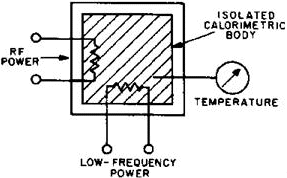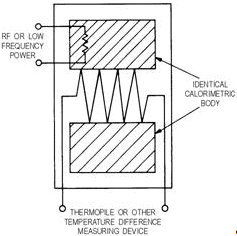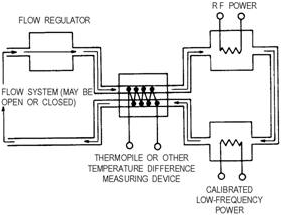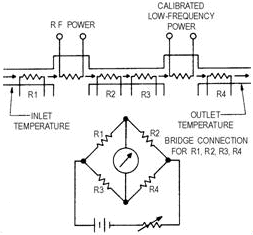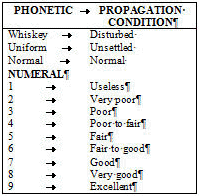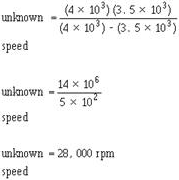Module 21 - Test Methods and Practices |
||||||||||||||||||||||||||||||||||||||||||||||||||
|
Module 21 − Test Methods and Practices
Pages i , 1−1, 1−11, 1−21, 2−1, 2−11, 2−21, 2−31, 2−41, 3−1, 3−11, 3−21, 3−31, 4−1, 4−11, 5−1, 5−11, 5−21, 5−31, AI−1 to AI−3, Index
loop 2. Both bridges are excited by a common 10-kHz source. The 10-kHz amplifier-oscillator supplies 10-kHz power to bias the thermistor in feedback loop 1 to produce the resistance required to balance the RF bridge. An equal amount of 10-kHz power is supplied by the same oscillator to the second thermistor in feedback loop 2 through two series-connected transformers. Feedback loop 2 balances the meter bridge. When RF is applied to the thermistor in the detection bridge (but not to the compensation and metering bridge), an amount of 10-kHz power is present, equal to the RF power being removed from the detection bridge by the self-balancing action of the bridge. Since the RF power replaced the 10-kHz power, the detection bridge is in balance; however, the metering bridge must be balanced by its separate feedback loop. Sufficient dc power to equal the 10-kHz power lost by the metering bridge is automatically replaced, balancing this loop. Hence the dc power applied to the metering bridge thermistor is equal to the microwave power applied to the detection bridge. The meter circuit senses the magnitude of the feedback current. The resultant meter current passes through a differential amplifier to the indicating meter. The two thermistors are matched with respect to their temperature characteristics; therefore, there is only a very small amount of drift of the zero point with ambient temperature changes. When there is a change in temperature, there is a change in the electrical power needed by the thermistors to maintain constant operating resistances. This change is automatically performed by feedback loop 1, which changes the amount of 10-kHz power for both thermistors by the proper amount. The dc power in feedback loop 2 is not changed; and since it is this dc power that is metered, the temperature change has not affected the meter indication.
CALORIMETERS
The calorimeters are the most accurate of all instruments for measuring high power. Calorimeters depend on the complete conversion of the input electromagnetic energy into heat. Direct heating requires the measurement of the heating effect on the medium, or load, terminating the line. Indirect heating requires the measurement of the heating effect on a medium or body other than the original power- absorbing material. Power measurement with true calorimeter methods is based solely on temperature, mass, and time. Substitution methods use a known, low-frequency power to produce the same physical effect as an unknown RF power being measured. Calorimeters are classified as STATIC (nonflow) types and CIRCULATING (flow) types.
Q-15. Power measurements performed with calorimeters are based on what three variables?
Static Calorimeters
The static calorimeter uses a thermally shielded body. Since an isolated body loses little heat to a surrounding medium, the temperature increase of the body is in direct proportion to the time of applied power. The product of the rate of temperature rise in the calorimetric body and its heat capacity equals applied power. Figure 3-18 illustrates a static-type calorimeter.
3-21
Figure 3-18. - Static calorimeter using low-frequency power substitution.
The most common type of static calorimeter is the ADIABATIC calorimeter. In the adiabatic meter, power is applied directly to a thermally isolated body; and the rate of temperature rise is determined from a temperature change measurement during a sufficiently long, known time interval. Figure 3-19 illustrates an adiabatic calorimeter using water as the body contained in a covered Dewar flask. a tapered-wall, open-ended waveguide contains a sealed, inclined glass partition to create a wedge-shaped water load of low-reflection coefficient. Thorough mixing of the water is accomplished with a stirrer, and a sensitive thermometer measures the temperature rise. a heating coil is wound around the waveguide inside the calorimeter and is used for calibrating purposes when low-frequency power is applied. This type of meter can be used for accurate measurement of several hundred watts of average power and can withstand 50 kilowatts of peak power.
Figure 3-19. - Adiabatic calorimeter.
3-22 The NONADIABATIC calorimeter uses an RF termination with a resistive film strip or LOSSY dielectric materials (solids or liquids that are designed to efficiently dissipate the applied power) as a load. Temperature indication can be accomplished with thermocouples, thermopiles, thermistors, thermometers, bimetallic strips, and manometers. Calibration is against a power standard or known low- frequency power. Based on the above principle, a coaxial calorimeter of good sensitivity with a short, 50-ohm resistive film on a lava (dielectric) center conductor, enclosed within a tapered, thin-walled outer conductor, is used for frequencies between 0 and 1.2 GHz. The RF termination is electrically connected to, but thermally isolated from, a massive mounting plate by a short section of silvered-lava coaxial line with a high thermal resistance. The steady-state temperature rise of the outer casing of the load with respect to the mounting plate is measured by a differential platinum-resistance thermometer in a Wheatstone bridge. Low-frequency power applied to the termination provides a method of calibration. Power in the range of 0 to 2.5 watts may be measured. a 70-second time constant and steady-state temperatures are attained in about 6 minutes. The small physical size of termination (to keep convective and radiative heat losses low) provides high sensitivity. Calibration with lower frequency power is extremely accurate, because the termination is broadband and should exhibit the same power distribution from dc to 10 gigahertz.
A twin calorimeter provides a method of using two calorimetric bodies thermally shielded against ambient temperature variations and improves sensitivity. Figure 3-20 illustrates this type of calorimetric device. The power to be measured is applied to one calorimetric body; the other calorimetric body acts as a temperature reference. The steady-state temperature difference between the two calorimeters is used as a measure of RF power. Calibration is performed by applying low-frequency power. a differential-air, thermometer-type temperature difference indicator, shown in figure 3-21, is used with a twin calorimeter to measure microwave power in the 0.1-mW range. This instrument consists of two similar glass cells connected by a capillary tube containing a liquid pellet. Each glass cell contains a tapered, carbon-coated strip; and the entire assembly is mounted in a rectangular waveguide. Balancing dc power heats one strip; the other strip is heated by RF power. The liquid pellet, which indicates the differential expansion of the air within the two cells, is viewed through an aperture in the waveguide wall, preferably with a microscopy for highest sensitivity. This procedure permits a 2% accuracy at 10 mW.
Figure 3-20. - Twin calorimetric system.
3-23
Figure 3-21. - Differential-air, thermometer-type calorimeter.
Flow Calorimeters
Flow calorimeters are classified by the type of circulating method used (open or closed), the type of heating used (direct or indirect), and the type of measurement performed (true calorimetric or substitution). Water or other calorimetric fluid is used only once in an open system. An overflow system is used to maintain a constant rate of flow. Closed systems recirculate the fluid continuously by means of a pump, and a cooling system restores the fluid to ambient temperatures prior to its return to the calorimeter. Closed systems are more elaborate and permit the use of fluids other than water.
Flow calorimeters provide the primary standards for the measurement of high power levels; and, in conjunction with calibrated directional couplers, attenuators, power dividers, or other similar devices serve to standardize medium- and low-power measuring instruments. The measurement time depends on the required time for the entering fluid to reach the outlet, where the rise in temperature is measured. The circulating fluid may serve in a dual capacity as the dissipative medium and coolant, using the direct heating method, or solely as a coolant, using the indirect heating method. Because of its excellent thermal properties and high dielectric losses at 1 GHz or higher, water is normally used in both heating methods. Water is rarely used as the fluid at frequencies lower than 100 MHz, because of insufficient dielectric losses. The indirect heating method offers a wider frequency and power-range coverage and can be used in substitution-type measurements.
True calorimetric measurements contain appreciable error, because of nonuniformity of flow rate, air bubbles, flow-rate measurement inaccuracies, and temperature rise. Flow regulators, bubble traps, and good thermal insulation are required to eliminate the majority of these errors. Substitution methods do not involve direct heat dissipation measurement of moving fluid. Greater accuracy is obtained because known low-frequency power is substituted for the unknown RF power, with all other measurement parameters remaining constant. The accuracy depends on the exactness of the low-frequency power determination and the degree to which factors remain fixed during the substitution of one type of power with another.
Figure 3-22 illustrates a flow calorimeter using low-frequency power substitution. Two different measurement techniques are possible with this type of meter: the calibration technique and the balance technique. The CALIBRATION TECHNIQUE uses an adjustable known power to exactly reproduce the same temperature indication originally obtained by the unknown RF power measurement. The BALANCE TECHNIQUE uses an initial low-frequency power (P1) to provide a steady-state temperature rise in the calorimetric fluid. When unknown RF power is applied, the original power (P1) is reduced to a new power (P2) to maintain the same temperature indication. Therefore, the actual power equals P1 minus P2. Figure 3-23 illustrates a widely used method of power measurement using a balanced-flow calorimeter. Temperature-sensitive resistors are bridge-connected as the thermometric elements and are balanced at ambient temperature prior to the application of power. Low-frequency balancing power and the unknown
3-24 RF power are applied to maintain the bridge at null. This occurs when the temperature rise caused by the unknown RF power equals the temperature rise caused by the known low-frequency power.
Figure 3-22. - Flow calorimetric system using substitution at low-frequency power.
Figure 3-23. - Balanced-flow calorimeter.
Q-16. What is the result of applying power to a calorimeter?
3-25
Frequency MEASUREMENTS
Frequency measurements are an essential part of preventive and corrective maintenance for communication and electronic equipment. Rotation frequencies of some mechanical devices must be determined; the output frequency of electric power generators is checked when the engine is started and during preventive maintenance routines; carrier equipment that operates in the audio-frequency range must be adjusted to operate at the correct frequencies; and radio transmitters must be accurately tuned to the assigned frequencies to provide reliable communications and to avoid interfering with radio circuits operating on other frequencies. These are only a few of the applications for making frequency measurements.
Frequency-MEASUREMENT Methods
Frequency-measuring equipment and devices, particularly those used to determine radio frequencies, constitute a distinct class of test equipment, because of the important and critical nature of such measurements. The requirement of precise calibration is extremely important in all frequency-measuring work. To provide accurate measurements, every type of frequency-measuring device must be calibrated against some frequency standard.
Frequency STANDARDS
Of considerable importance in the measurements of frequency or wavelength are the standards against which frequency-measuring devices are compared and calibrated. Frequency standards belong to two general categories: primary and secondary standards. The PRIMARY Frequency STANDARD maintained by the U.S. National Bureau of Standards has long-term stability and an accuracy of 1 part in 1012, using an atomic clock. a SECONDARY Frequency STANDARD is a highly stable and accurate standard that has been calibrated against the primary standard. Secondary standards are maintained by calibration laboratories that service your test equipment.
The National Bureau of Standards provides time and frequency standards from station WWV at Fort Collins, Colorado, and from station WWVH at Kekaha, Kauai, Hawaii. The following technical radio services are given continuously by these stations:
· Standard audio frequencies
The UTC scale uses the ATOMIC SECOND as a time interval. UT 1 is based on the earth's uniform rate of rotation. Since the earth's rotation is not precisely uniform, UT1 is an adjustable interval.
3-26 To ensure reliable coverage of the United States and extensive coverage of other parts of the world, radio stations WWV and WWVH provide the primary standard radio frequencies listed in table 3-1. The transmission of WWV and WWVH are interrupted for 5 minutes of each hour. The silent period begins at 15 minutes past the hour for station WWVH and 45 minutes past the hour for station WWV. These silent periods are provided to eliminate errors caused by interference.
Table 3-1. - NBS Frequency Standards and Time Transmission
Two primary standard audio-frequency tones (440 Hz and 600 Hz) are broadcast on all WWV and WWVH carrier frequencies. In the absence of a message, a 500-Hz tone is broadcast during the message interval. The 440-Hz signal that denotes the 1-hour mark is the standard musical pitch, a above middle C. The 600-Hz tone provides a frequency standard for checking the 60-Hz power-line frequency.
The standard time pulse marking interval of 1 second consists of five cycles of a 1,000-Hz tone at WWV and six cycles of a 1,200-Hz tone at WWVH. These marker pulses are heard as clock ticks. Intervals of 1 minute are marked by a 0.8-second, 100-Hz tone for WWV and a 0.8-second, 1,200-Hz tone for WWVH. Each hour is marked by a 0.8-second, 1,500-Hz tone on both stations. Universal Time Coordinated (UTC) is announced on WWVH between the 45 and 52.5 seconds of each minute and on WWV between the 52.5 and 60 seconds of each minute.
An announcement of radio propagation conditions (geophysical alert) for the North Atlantic area is broadcast by station WWV in voice at 18 minutes after each hour. For example, these short-term announcements might state, "The radio propagation quality forecast at ... (normal, unsettled, disturbed)." The propagation format is repeated phonetically and in numerical code to ensure clarity. The letter designations N, U, and W, signifying "normal," unsettled," and "disturbed," respectively, classify the radio propagation conditions at the time of the broadcast. The digits from 1 to 9 indicate the expected radio propagation conditions during the next 6 hours; refer to table 3-2 for code interpretations. The National Bureau of Standards forecasts are based on information obtained from a worldwide network of geophysical and solar observations.
3-27
Table 3-2. - NBS Radio Propagation Coding
Q-17. What government agency is responsible for monitoring our primary frequency standards?
MECHANICAL ROTATION and VIBRATION Methods
There are many instances when you are very much concerned with the question of rotational or vibratory speeds. Knowledge of rotational speeds is necessary where the output of a direct current generator has fallen below a minimum desired output or where the speed of a motor (such as the motor in a teletypewriter or radar antenna) must be maintained at a constant value. There are many instruments that you can use for this purpose, such as tuning forks, stroboscopes, vibrating-reed meters, and electromechanical counters. The oscilloscope and the frequency counter are two of the other devices which may be used, but their use may require the employment of accessory equipment.
Tuning Fork Methods
a tuning fork is generally used in conjunction with the measurement of the rotational speed of a teletypewriter or facsimile motor but is not limited to this application. However, you must remember that the tuning fork can be used at only one frequency, the frequency of vibration for which it was manufactured, and therefore cannot be used on variable-speed motors. To use the tuning fork, you direct a source of light upon the point to be observed. In the case of a teletypewriter, a black-and-white segmented target is painted on the outer circumference of the motor governor. Radial spokes in a flywheel could be used equally well. Permit the motor to reach operational speed under normal load conditions; otherwise, the motor will slow down considerably when the normal load is applied. Strike the tuning fork against the side of your hand to set it into vibration. Then observe the target through the slots in the plates attached to the tines of the fork. The correct speed is obtained when the segments of the target appear to be stationary. If the segments seem to move backward, apparently against the known motor rotational direction, the speed is too low. If the segments seem to move forward, the speed is too high. There is also the possibility that the target segments will appear to jump back and forth or to disappear suddenly. Such erratic action is often because of governor malfunctioning. The correct speed adjustment is reached when the targets appear to be stationary.
Q-18. What is the primary measurement application for tuning forks?
3-28 Stroboscope Methods
When using a stroboscope to measure the speed of rotating or reciprocating mechanisms, hold the instrument so that the light from the stroboscope lamp falls directly on the part to be observed. If the part is uniform, or symmetrical, place an identification mark with chalk or a grease pencil on the portion to be observed. This method provides a positive means of identification, because if only one reference mark is observed during measurement, you can be sure that either the fundamental synchronization or a submultiple thereof has been obtained. If the approximate speed of rotation is known, the stroboscope controls may be set to the appropriate positions prior to actual measurement. The main frequency control that determines the rate of the flashing light is then varied until the reference mark on the moving part appears to be standing still. The calibrated scale of the stroboscope will then show the speed directly in revolutions per minute (rpm).
If you have no idea of the speed of the moving part, it is best to start the measurement procedure at the highest frequency that the stroboscope can deliver. The flashing rate of the stroboscope can then be gradually reduced until a single stationary image of the reference mark is obtained. This is the point of fundamental synchronism that corresponds to the speed of the moving part. Do not continue to reduce the flashing rate of the instrument beyond this point without a valid reason for doing so. If you do continue the reduction, a stationary image will still be observed, but the stroboscope will indicate a submultiple of the true rotational speed; thus, a measurement error will be introduced.
Stroboscopes generally have a high- and low-range switch. The typical low range is from 600 to 3,600 rpm, and the upper range is from 3,600 to 15,000 rpm; there is a slight overlap in ranges to ensure reliable frequency coverage. In view of the limitation imposed by flasher tube life, the stroboscope should always be operated at a flashing rate that is as low as possible, consistent with the rotational speed of the observed part. If you should be required to operate this instrument over a long period of time, use a submultiple of the fundamental synchronous speed. The pattern will remain just as stationary, and the tube life will be greatly extended. In addition, the quality of the light is better at the lower ranges than at the upper end of the scale. Sometimes you will encounter a rotating or vibrating device that is moving faster (or slower) than the measuring range of the stroboscope will accommodate. Although such speeds can still be measured, you must use the multiple or submultiple synchronism points.
There are two methods of measuring high speeds. The first method is to obtain a single stationary image of the rotating object at a subharmonic speed relationship and to record that value as A. Then obtain a second single stationary image at the next lower subharmonic speed relationship, and record this value as B. The unknown speed may then be computed from the following formula:
For example, assume reading a was 4,000 rpm and reading B was 3,500 rpm. The computation would be as follows:
3-29
The second method is used where the value of A ´ B becomes progressively smaller. The a reading is obtained as in the previous example (for the sake of easier computation, suppose that the a reading is still 4,000 rpm). Then obtain another submultiple reading for B, keeping in mind the number of times a stationary single image was observed. If a stationary single image was observed seven different times and the final B reading was 2,000 rpm, the calculation would become as follows:
At speeds lower than the lowest range of the stroboscope, multiple images will be observed. For example, assume a dial reading of 900 rpm was obtained when two stationary images were observed. Then dividing the rpm by the number of images will give the unknown shaft speed, as shown below:
3-30
|
||||||||||||||||||||||||||||||||||||||||||||||||||
